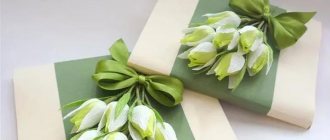3.5/5 — (2 votes)
Good day!
I think that it is customary for everyone to give flowers. It’s both convenient and beautiful, and what a magical aroma they give off. Many people prefer to make such gifts for every holiday, and some for any occasion. There is nothing wrong. Our children in schools and kindergartens make them from scrap materials. They decorate postcards or other souvenirs. The most popular today are roses, second place... Guess for yourself? Tulips, so, I propose to make them from paper today.
And if you have the time and desire, then of course you can grow them in your garden. But, since this process is labor-intensive, and you won’t be able to cut them at any time of the year, so let’s look at the crafts with me.
This is a fun activity, especially if you have children, they will be absolutely delighted and will help you create such colorful flowers. Or they will bring you such gifts on March 8, or your birthday. Tulips are often made for veterans on May 9 or February 23.
In any case, such masterpieces do not leave anyone unnoticed, because such paper flowers are stored for a very long time and can please the eye for many years.
Origami paper tulip
- In order to make an origami tulip we need one square sheet of paper;
- Bend it in half on all sides, as shown in Figure 2;
- Now we need to fold the sheet into a triangle. Bend the square in half, connect the left and right corners inside, as shown in Figure 3;
- In front of you is a triangle, you need to bend the corners up, Figure 4;
- The same thing needs to be done from the other side, Figure 5;
- Bend one side of the diamond as shown in Figure 5, 6;
- Connect the right and left corners of the rhombus in the middle, Figure 7.8;
- Turn the figure over and repeat the same movements, Figure 8.9;
- Spread your flower, figure 9;
- Bend the petals to make the flower look more beautiful;
- Ready.
The emergence of origami
The centuries-old history of creating paper figures originates in Japan, intertwined with the history of paper. In those days, such an activity of folding models was available only to rich and noble people, since the cost of paper was very high. Creations made from papyrus were exclusively ceremonial in nature.
Soon, origami began to be used as distinctive signs of social classes. In the twentieth century, the universal “Origami ABC” was created, various symbols, graphic signs, the symbols of which help to record on paper the entire process of folding origami figures. Today, this favorite pastime of many people has turned into an entertaining hobby.
Simple tulip
You will need: two sheets of colored paper, red and green.
- Take a square sheet of colored red paper, bend it into a triangle, Figure 2;
- Bend the triangle in half and put it back, this is how we know where the middle of the triangle is;
- Fold the right and left corners as shown in picture 3;
- Bend the lower acute corner upward, Figure 4.5;
- The flower is ready, now we’ll make a leaf;
- Take a square sheet of colored green paper, place it in front of you in a diamond shape and bend it in half to find out where the middle is, Figure 1;
- Bend the right and left corners to the center, Figure 2;
- Bend the figure in half, bend the protruding tail up, as shown in Figure 3;
- Done, all that remains is to connect the leaf and flower, you can glue them together with glue.
Modular creation
Making crafts (in this case, a paper tulip using the origami technique) is always very interesting and exciting, especially if you involve a child in the process. Modular creativity should be approached gradually, starting with learning and mastering the easier origami technique. And now everything is in order.
Techniques and types of origami
The origami technology itself is based on a unified system of folds, turns, folds and bends of the paper base. The classic technique is to use only one plain square sheet of paper. The work takes place without scissors and glue.
Today, origami forms are partially abstracted from this canon. There are several types of origami. They differ in the degree of complexity, as well as in the technique of execution of the craft. If you are just beginning to practice this art, you should turn to creating the simplest figures, for example, a tulip from origami paper.
Simple origami. This style is characterized by its limited use of a pleat. Simple patterns help kids develop fine motor skills.
Try creating a tulip using this technique:
- Fold the paper square as if you were making a paper airplane.
- Fold both triangles inward.
- Bend the bottom part towards a triangle.
It turns out the stem and leaf of the flower.
Let's create a tulip ourselves
- Fold the square in half.
- Now fold the triangle in half.
- Place the resulting small triangles so that their ends extend beyond the edge of the large triangle.
- Bend the base a little.
- Place the resulting bud on the stem.
The classic type of origami is done in a similar way to the simple style. A square of paper is used. Glue and scissors are not used.
Kirigami is a product made by folding paper sheets of various shapes. This technique involves using (if necessary) scissors and ready-made stencils.
Folding along the development. The work is carried out according to the proposed drawing with all the folds of the finished product (tulip). This technology is somewhat more complex than traditional folding.
Wet folding basically involves using paper soaked in water. This is done so that the figurine being made has smoother lines and is more expressive and natural.
This style of origami can be used by having paper that has water-soluble glue added during its production. Basically these are all types of thick paper.
Modular origami is a masterpiece created from a certain number of modules that are pre-folded into the desired configuration.
A very interesting type of modular origami is the Kusudama technique. Its peculiarity lies in the folding of elements in the form of cones into ball shapes. The work most often uses the process of stitching parts together. The flower arrangements created in this way are very elegant and fantastically beautiful. At first glance, it is difficult to believe that this is a paper product.
What you need for creativity
Having settled on any style, you need to prepare everything you need to practice origami:
- special papyrus for creativity “kami” in the form of a square or thick colored paper, cardboard;
- foil samples;
- stationery;
- optionally, various additional decorative materials.
Options for making an origami tulip
The proposed step-by-step implementation of an origami tulip made of paper will help you master this technology for creating a beautiful flower:
- a square-shaped sheet needs to be folded in half;
- repeat folding;
- lightly pull one layer of paper by the upper left corner, open it and flatten it thoroughly;
- turn the resulting sample over and fold it into a “valley”;
- Also open and smooth out the next part of the workpiece;
- the result was the base shape of the product “double triangle”;
- on one side, bend the corners to the top, perform the same action on the other side;
- turn over the resulting figure and do the same on the other part;
- the corner must be bent so that it goes beyond the diagonal, then repeat;
- the second corner must be inserted into the resulting pocket, again - repeat;
- inflate the figure through the pocket;
- Bend four petals slightly.
There is a beautiful tulip in front of you. All that remains is to create the stem. There are several options. For example, like this:
- a square sheet is folded diagonally;
- unfolds;
- you need to outline (it was obtained by folding diagonally) the required line and fold the upper and lower corners to it;
- the result is a “kite”, which should be rotated 90°, resulting in two “valley” folds;
- once again fold the created figure into a “valley” and then in half;
- now you need to shape the “valley” in half lengthwise and turn it;
- by drawing out a small triangle, you get a tulip stem.
All that remains is to connect the origami tulip with the origami stem.
Another option for creating this cute spring flower is offered. To make it, prepare paper of any color and scissors and you can start creating:
- Square sheet of various formats. Experience in this technique should be taken into account. A larger sheet will help beginners understand the diagram more easily. The small format is a more complex option. Double-sided colored paper will add volume to the flowers. By combining different formats and colors, you can create an unusually beautiful bouquet of tulips.
- The sheet is folded in half diagonally.
- The fold is repeated so that two small triangles are formed.
- The created structure is deployed.
- Repeat the process from the beginning of work to the fourth point, observing the sequence.
- Based on the indicated diagram, the parts on which the fold lines are marked are assembled into the intended figure, while the edges of one of the sides are raised.
- The fifth and sixth points are repeated, but with the next part.
- Fold lines are defined to carry moving elements.
- Similar steps with the adjacent side.
- Unfold the upper petals of the tulip, creating a real flower.
- The tulip is attached to the stem.
There are plenty of options on how to make a tulip from origami paper. The choice is yours.
When practicing origami, you should focus on this. First of all, focus. This creativity does not tolerate “careless” work. The more careful you are when creating a craft, the more beautiful the tulip will be. By the way, there will be inspiration, creative imagination, and the use of various decorative ornaments.
A magnificent tulip made in the style of modular origami. It is made from small rectangles cut from ordinary office paper of different colors.
You need to prepare 105 triangular modules from which the flower is made. To complete this work, it is best to contact the masters for help or attend their master class.
DIY paper tulip
In order to make such a tulip, you will need:
- colored paper in red, green, yellow and black;
- wooden stick;
- glue;
- scissors.
- We need to make blanks, cut out flowers of two different sizes, larger and smaller, and a center for the flower, as shown in Figure 1;
- Glue everything together, figure 2,3;
- When the small flower is ready, place a larger piece on top and, placing the petals overlapping each other, glue the flower, this must be done so that the flower holds its shape well;
- The flower is ready, all that remains is to make a couple of leaves from colored green paper and put the whole craft together;
- Ready.
Options for experienced craftsmen
Those who have been seriously involved in origami for a long time can try to make a tulip according to the following step-by-step diagram. It is quite complex, but the flower turns out to be not just a beautiful craft, but a real work of paper art. In the future, these elements can be used to create a decorative kusudama ball.
There are several varieties of tulips using the modular origami technique. For this flower you will need 175 1/32 modules. Of them:
- 100 white;
- 75 pink.
Dimensions of the finished flower: 6x28.5 cm.
Corrugated paper tulip
To make this flower you will need:
- corrugated paper;
- wire;
- green electrical tape or tape;
- We have a foam ball, you can also use candy;
- glue.
- First, you need to cut out petals from corrugated paper; the more petals there are in 1 flower, the more magnificent it will be.
- When the petals are ready, connect the wire and the foam ball using glue or electrical tape;
- As if we were winding the petals onto the finished base;
- When you have attached all the petals, fasten them together with glue or electrical tape;
- Ready.
Origami and the 21st century
What does this art represent today? This is a developing and educational activity with children. This is a hobby of many adults. This is an integral design element. This is an important attribute of the holidays of the peoples of the world. This is theatrical art. This is an independent business.
It is worth thinking about the conclusions of psychologists and neurologists. By doing origami, you create an excellent platform for the harmonious development of the cerebral hemispheres. You also give your psyche the opportunity to make the most of its resources. And this is quite a lot in the age of crazy speeds, information overload, and all kinds of stressful situations.
Today, origami is part of an extracurricular curriculum for both children and adults.
Practice origami yourself, with your children, the whole family and enjoy the beauty created with your own hands.
Paper tulip applique
In order to make this craft you will need:
- sheets of multi-colored paper;
- cardboard;
- scissors;
- glue.
- Let's make blanks, cut out all the necessary flower petals, green leaves and stems from colored paper.
- For 1 tulip flower we will need 6 blanks (paper balls from our previous article were made using a similar technique);
- For 1 piece you need to cut out a square piece of paper, bend it in half and all you need to cut out of the square is the shape you need. Do not cut the fold line.
- Next, cut out the remaining 5 blanks in the same way;
- Now you need to glue everything together, connect the blanks one by one, gluing them together;
- We have created a kind of accordion; glue the first and last blanks to the cardboard.
- Done, now all that remains is to glue the stem and leaves.
Easy tulips using origami technique for children (step-by-step diagrams)
And for those who like to fold paper and make airplanes and boats out of it, or other funny things, these diagrams will definitely come in handy. After all, tulips can also be folded easily and quickly using the origami technique. Step by step and the souvenir is ready. And in order for the flower to open, you will need to blow into it).
I hope the whole sequence of actions is clear to you, but here’s how it looks more clearly if you look at it live from colored double-sided paper.
All that remains is to attach the stem and leaf to the bud.
And then collect a whole composition of multi-colored flowers.
There is a slightly simpler way of folding, I also show it:
Or use this instruction, here the stem is also folded using origami.
And then the bud and stem are glued together with glue.
As a result, these wonderful tulips come out that can stand on their own on the desktop; use only thick paper.
There is a folding method in which the tulip turns out to be opening, you can even hide something in it, for example a wish.
Step-by-step instruction
- cut petal-colored paper into small squares,
- Fold each leaf in half, smooth the fold,
- put it with the fold to the left and draw two lines on the top with an angle downward, reminiscent of the battlements on the Kremlin wall,
- round the lower right corner,
- cut along the drawn contours and unfold.
The result is a flower template. We repeat three more times and get four silhouettes of a flower with a fold.
Note!
Crochet rose - diagrams and descriptions of how to crochet a rose with your own hands. Crochet technology + interesting craft ideas
- DIY edible bouquets - TOP 130 photos with instructions for creating a bouquet with your own hands. Creative ideas with simple diagrams and photos of finished works
- Craft primroses - simple instructions for creating crafts from scrap materials. Schemes of beautiful DIY products + photo reviews
Cut out two elongated sheets from green paper. We wrap the stick with green adhesive paper or paint it. You can make a stem stick by rolling a paper tube.
Flower assembly
- glue the black fringe to the tip of the wire, forming a tassel,
- pierce the yellow circle with a wire and attach a drop of glue to the tassel - the core is ready,
- Glue small petals in a circle to the core,
- Glue the large petals, covering the edges of the small ones,
- wrap the bottom of the flower with adhesive tape,
- then wrap the wire, attaching first a small sheet, then a larger one.
Bud
- cut six strips 10 x 2 cm for buds,
- stepping back 2 cm from the edge, twist it one turn and turn the edge inward - this is the top edge,
- stepping back 1 cm from the edge, twist the tip one turn and turn it inward - this is the lower edge of the petal,
- form a convexity of the petal, slightly stretching the middle,
- the bottom edge should be a little wider,
- trim and fix the folded edges with glue,
- repeat the steps with the remaining petals,
- glue three petals to the core,
- glue the three remaining petals in a checkerboard pattern,
- wrap the base of the flower with adhesive tape,
- Continue winding by attaching both sheets.
A sweet surprise is ready.
Note!
DIY fruit bouquets - TOP-200 photos with instructions for creating a bouquet of fruits with your own hands. Unconventional ideas with simple diagrams and work overviews
Crocheted flowers: TOP-160 photos and step-by-step knitting pattern, review of finished products with your own hands. Crochet master class for beginners
Paper lily - TOP 100 photos of the best product options. Master class with step-by-step diagrams and drawings for creating an origami lily with your own hands
Blanks
- cut out six petals from paper in the shape of an elongated trapezoid with rounded edges: three smaller and three larger,
- slightly crumple the narrow edge, while carefully stretching the paper closer to the middle: we form a bulge of the petal,
- on the contrary, stretch the wide edge slightly in places, forming scallops,
- so prepare six petals,
- cut two sheets of different sizes from green paper,
- cut a circle with a diameter of 1 cm from yellow paper,
- Cut the black strip into fringe.
Flower assembly
- Lubricate half of the bud up to the fold with glue and press firmly to the second template, aligning the edges,
- repeat two more times,
- Lubricate the last two halves that are not glued together with glue, insert the stem stick and align the edges,
- Glue both leaves onto the stem.
The tulip is ready.











